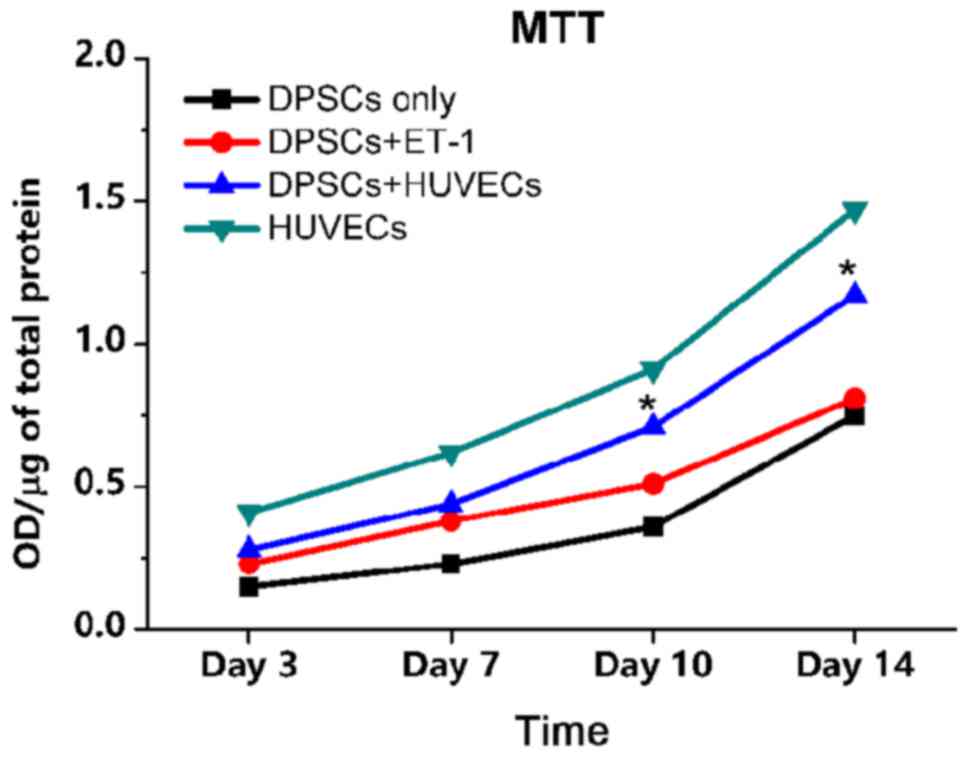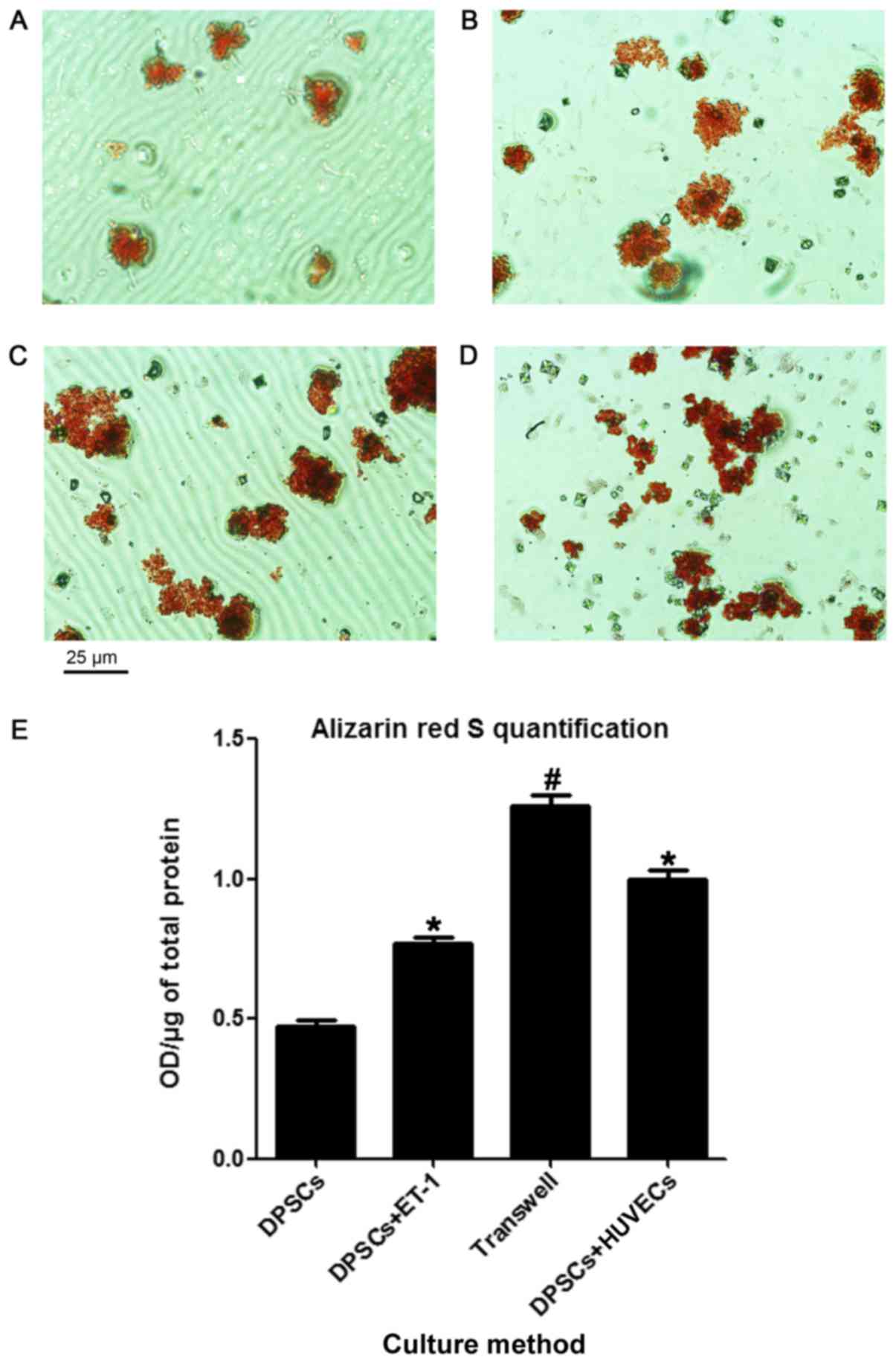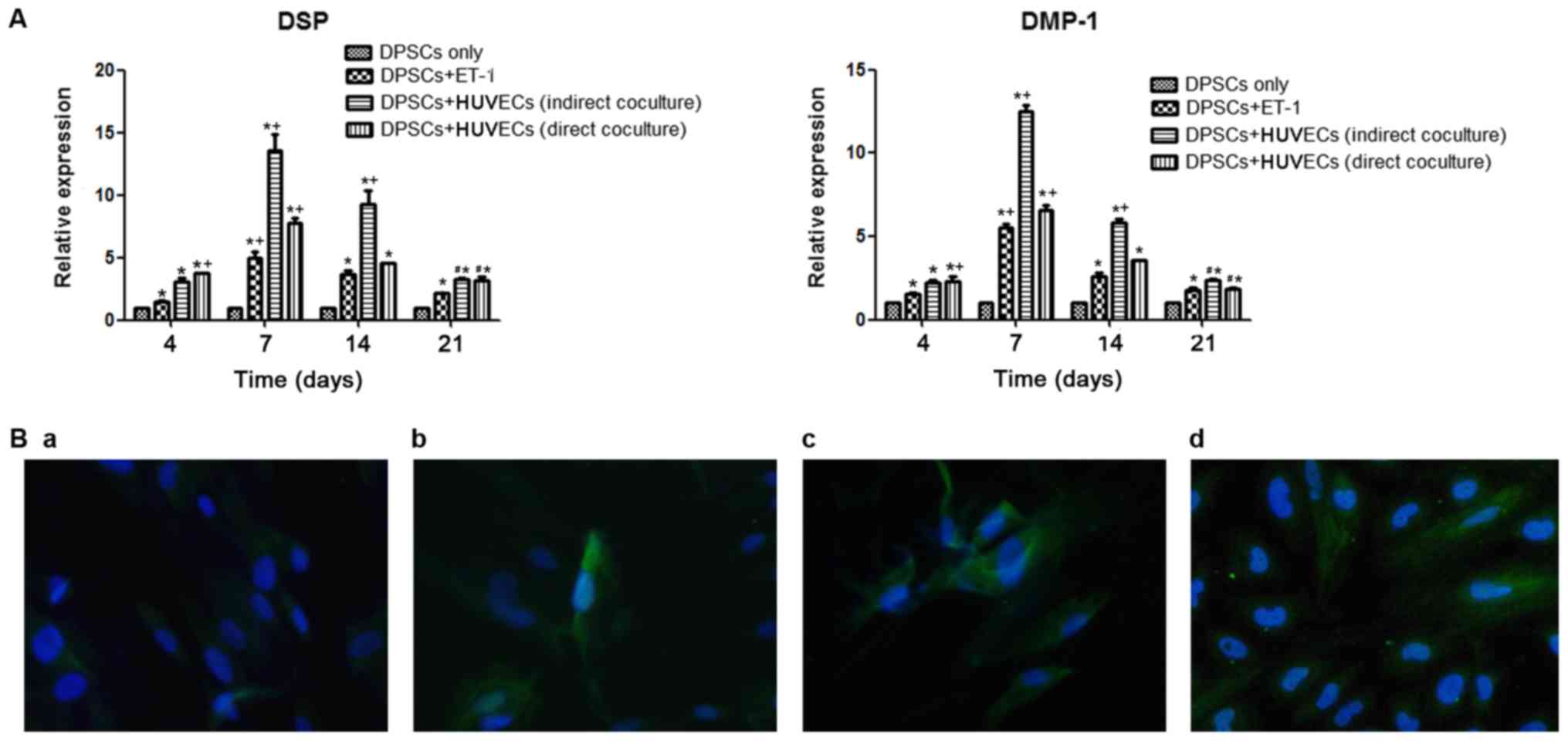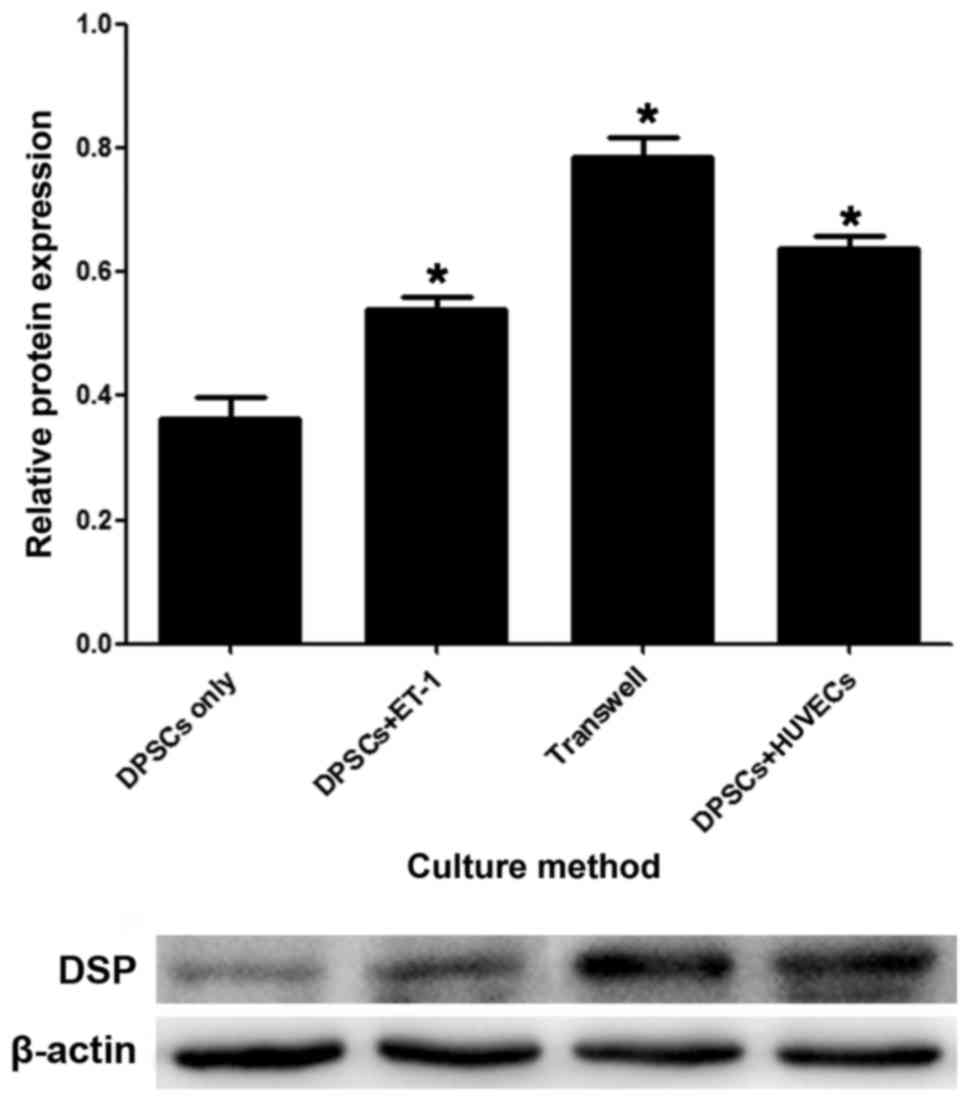|
1
|
Gronthos S, Mankani M, Brahim J, Robey PG
and Shi S: Postnatal human dental pulp stem cells (DPSCs) in vitro
and in vivo. Proc Natl Acad Sci USA. 97:13625–13630. 2000.
View Article : Google Scholar : PubMed/NCBI
|
|
2
|
Shi S and Gronthos S: Perivascular niche
of postnatal mesenchymal stem cells in human bone marrow and dental
pulp. J Bone Miner Res. 18:696–704. 2003. View Article : Google Scholar : PubMed/NCBI
|
|
3
|
Spath L, Rotilio V, Alessandrini M,
Gambara G, De Angelis L, Mancini M, Mitsiadis TA, Vivarelli E, Naro
F, Filippini A and Papaccio G: Explant-derived human dental pulp
stem cells enhance differentiation and proliferation potentials. J
Cell Mol Med. 14:1635–1644. 2010. View Article : Google Scholar : PubMed/NCBI
|
|
4
|
Mathieu S, El-Battari A, Dejou J and About
I: Role of injured endothelial cells in the recruitment of human
pulp cells. Arch Oral Biol. 50:109–113. 2005. View Article : Google Scholar : PubMed/NCBI
|
|
5
|
Nugent MA and Iozzo RV: Fibroblast growth
factor-2. Int J Biochem Cell Biol. 32:115–120. 2000. View Article : Google Scholar : PubMed/NCBI
|
|
6
|
Dissanayaka WL, Zhan X, Zhang C,
Hargreaves KM, Jin L and Tong EH: Coculture of dental pulp stem
cells with endothelial cells enhances osteo-/odontogenic and
angiogenic potential in vitro. J Endod. 38:454–463. 2012.
View Article : Google Scholar : PubMed/NCBI
|
|
7
|
Martin P: Wound healing-aiming for perfect
skin regeneration. Science. 276:75–81. 1997. View Article : Google Scholar : PubMed/NCBI
|
|
8
|
Wang DS, Miura M, Demura H and Sato K:
Anabolic effects of 1,25-dihydroxyvitamin D3 on osteoblasts are
enhanced by vascular endothelial growth factor produced by
osteoblasts and by growth factors produced by endothelial cells.
Endocrinology. 138:2953–2962. 1997. View Article : Google Scholar : PubMed/NCBI
|
|
9
|
Saleh FA, Whyte M, Ashton P and Genever
PG: Regulation of mesenchymal stem cell activity by endothelial
cells. Stem Cells Dev. 20:391–403. 2011. View Article : Google Scholar : PubMed/NCBI
|
|
10
|
Bouletreau PJ, Warren SM, Spector JA,
Peled ZM, Gerrets RP, Greenwald JA and Longaker MT: Hypoxia and
VEGF up-regulate BMP-2 mRNA and protein expression in microvascular
endothelial cells: Implications for fracture healing. Plast
Reconstr Surg. 109:2384–2397. 2002. View Article : Google Scholar : PubMed/NCBI
|
|
11
|
Liu L, Ling J, Wei X, Wu L and Xiao Y:
Stem cell regulatory gene expression in human adult dental pulp and
periodontal ligament cells undergoing odontogenic/osteogenic
differentiation. J Endod. 35:1368–1376. 2009. View Article : Google Scholar : PubMed/NCBI
|
|
12
|
Sueyama Y, Kaneko T, Ito T, Kaneko R and
Okiji T: Implantation of endothelial cells with mesenchymal stem
cells accelerates dental pulp tissue regeneration/healing in
pulpotomized rat molars. J Endod. 43:943–948. 2017. View Article : Google Scholar : PubMed/NCBI
|
|
13
|
Yanagisawa M, Inoue A, Ishikawa T, Kasuya
Y, Kimura S, Kumagaye S, Nakajima K, Watanabe TX, Sakakibara S,
Goto K, et al: Primary structure, synthesis, and biological
activity of rat endothelin, an endothelium-derived vasoconstrictor
peptide. Proc Natl Acad Sci USA. 85:6964–6967. 1988. View Article : Google Scholar : PubMed/NCBI
|
|
14
|
Griswold DE, Douglas SA, Martin LD, Davis
TG, Davis L, Ao Z, Luttmann MA, Pullen M, Nambi P, Hay DW and
Ohlstein EH: Targeted disruption of the endothelin-B-receptor gene
attenuates inflammatory nociception and cutaneous inflammation in
mice. J Cardiovasc Pharmacol. 36 5 Suppl 1:S78–S81. 2000.
View Article : Google Scholar : PubMed/NCBI
|
|
15
|
Pomonis JD, Rogers SD, Peters CM, Ghilardi
JR and Mantyh PW: Expression and localization of endothelin
receptors: Implications for the involvement of peripheral glia in
nociception. J Neurosci. 21:999–1006. 2001. View Article : Google Scholar : PubMed/NCBI
|
|
16
|
Hirata Y and Ishimaru S: Effects of
endothelin receptor antagonists on endothelin-1 and inducible
nitric oxide synthase genes in a rat endotoxic shock model. Clin
Sci (Lond). 103 Suppl 48:332S–335S. 2002. View Article : Google Scholar : PubMed/NCBI
|
|
17
|
Yanagisawa M, Kurihara H, Kimura S, Tomobe
Y, Kobayashi M, Mitsui Y, Yazaki Y, Goto K and Masaki T: A novel
potent vasoconstrictor peptide produced by vascular endothelial
cells. Nature. 332:411–415. 1988. View
Article : Google Scholar : PubMed/NCBI
|
|
18
|
Sin A, Tang W, Wen CY, Chung SK and Chiu
KY: The emerging role of endothelin-1 in the pathogenesis of
subchondral bone disturbance and osteoarthritis. Osteoarthritis
Cartilage. 23:516–524. 2015. View Article : Google Scholar : PubMed/NCBI
|
|
19
|
Yuan W, Zhao MD, Yuan FL, Che W, Duan PG,
Liu Y and Dong J: Association of endothelin-1 expression and
cartilaginous endplate degeneration in humans. PLoS One.
8:e600622013. View Article : Google Scholar : PubMed/NCBI
|
|
20
|
Inoue A, Yanagisawa M, Kimura S, Kasuya Y,
Miyauchi T, Goto K and Masaki T: The human endothelin family: Three
structurally and pharmacologically distinct isopeptides predicted
by three separate genes. Proc Natl Acad Sci USA. 86:2863–2867.
1989. View Article : Google Scholar : PubMed/NCBI
|
|
21
|
W BF, Kristian HA, Ohlsson L, Tolstrup CA,
Warfvinge K and Edvinsson L: Increased endothelin-1-mediated
vasoconstriction after organ culture in rat and pig ocular arteries
can be suppressed with MEK/ERK1/2 inhibitors. Acta Ophthalmol. Jan
25–2018.(Epub ahead of print).
|
|
22
|
Rapoport RM and Merkus D: Endothelin-1
regulation of exercise-induced changes in flow: Dynamic regulation
of vascular tone. Front Pharmacol. 8:5172017. View Article : Google Scholar : PubMed/NCBI
|
|
23
|
Vanhoutte PM: Say No to ET. J Auton Nerv
Syst. 81:271–277. 2000. View Article : Google Scholar : PubMed/NCBI
|
|
24
|
De Mey JG and Vanhoutte PM: End o' the
line revisited: Moving on from nitric oxide to CGRP. Life Sci.
118:120–128. 2014. View Article : Google Scholar : PubMed/NCBI
|
|
25
|
Shioide M and Noda M: Endothelin modulates
osteopontin and osteocalcin messenger ribonucleic acid expression
in rat osteoblastic osteosarcoma cells. J Cell Biochem. 53:176–180.
1993. View Article : Google Scholar : PubMed/NCBI
|
|
26
|
Sasaki T and Hong MH: Localization of
endothelin-1 in the osteoclast. J Electron Microsc (Tokyo).
42:193–196. 1993.PubMed/NCBI
|
|
27
|
Warner TD: Endothelin and its inhibitors.
Springer-Verlag; Berlin: pp. 149–150. 2001
|
|
28
|
Neuhaus SJ and Byers MR: Endothelin
receptors and endothelin-1 in developing rat teeth. Arch Oral Biol.
52:655–662. 2007. View Article : Google Scholar : PubMed/NCBI
|
|
29
|
Khan ZA, Farhangkhoee H, Mahon JL, Bere L,
Gonder JR, Chan BM, Uniyal S and Chakrabarti S: Endothelins:
Regulators of extracellular matrix protein production in diabetes.
Exp Biol Med (Maywood). 231:1022–1029. 2006.PubMed/NCBI
|
|
30
|
Gilbert TM, Pashley DH and Anderson RW:
Response of pulpal blood flow to intra-arterial infusion of
endothelin. J Endod. 18:228–231. 1992. View Article : Google Scholar : PubMed/NCBI
|
|
31
|
Pourjafar M, Saidijam M, Mansouri K, Malih
S, Nejad Ranjbar T, Shabab N and Najafi R: Cytoprotective effects
of endothelin-1 on mesenchymal stem cells: An in vitro study. Clin
Exp Pharmacol Physiol. 43:769–776. 2016. View Article : Google Scholar : PubMed/NCBI
|
|
32
|
Liu M, Sun Y, Liu Y, Yuan M, Zhang Z and
Hu W: Modulation of the differentiation of dental pulp stem cells
by different concentrations of β-glycerophosphate. Molecules.
17:1219–1232. 2012. View Article : Google Scholar : PubMed/NCBI
|
|
33
|
Livak KJ and Schmittgen TD: Analysis of
relative gene expression data using real-time quantitative PCR and
the 2(-Delta Delta C(T)) method. Methods. 25:402–408. 2001.
View Article : Google Scholar : PubMed/NCBI
|
|
34
|
Hutley LJ, Herington AC, Shurety W, Cheung
C, Vesey DA, Cameron DP and Prins JB: Human adipose tissue
endothelial cells promote preadipocyte proliferation. Am J Physiol
Endocrinol Metab. 281:E1037–E1044. 2001. View Article : Google Scholar : PubMed/NCBI
|
|
35
|
Villars F, Guillotin B, Amédée T, Dutoya
S, Bordenave L, Bareille R and Amédée J: Effect of HUVEC on human
osteoprogenitor cell differentiation needs heterotypic gap junction
communication. Am J Physiol Cell Physiol. 282:C775–C785. 2002.
View Article : Google Scholar : PubMed/NCBI
|
|
36
|
Kaigler D, Krebsbach PH, West ER, Horger
K, Huang YC and Mooney DJ: Endothelial cell modulation of bone
marrow stromal cell osteogenic potential. FASEB J. 19:665–667.
2005. View Article : Google Scholar : PubMed/NCBI
|
|
37
|
Crisan M, Yap S, Casteilla L, Chen CW,
Corselli M, Park TS, Andriolo G, Sun B, Zheng B, Zhang L, et al: A
perivascular origin for mesenchymal stem cells in multiple human
organs. Cell Stem Cell. 3:301–313. 2008. View Article : Google Scholar : PubMed/NCBI
|
|
38
|
Arai K and Lo EH: An oligovascular niche:
Cerebral endothelial cells promote the survival and proliferation
of oligodendrocyte precursor cells. J Neurosci. 29:4351–4355. 2009.
View Article : Google Scholar : PubMed/NCBI
|
|
39
|
Vernon SM, Campos MJ, Haystead T, Thompson
MM, DiCorleto PE and Owens GK: Endothelial cell-conditioned medium
downregulates smooth muscle contractile protein expression. Am J
Physiol. 272:C582–C891. 1997. View Article : Google Scholar : PubMed/NCBI
|
|
40
|
Guillotin B, Bareille R, Bourget C,
Bordenave L and Amédée J: Interaction between human umbilical vein
endothelial cells and human osteoprogenitors triggers pleiotropic
effect that may support osteoblastic function. Bone. 42:1080–1091.
2008. View Article : Google Scholar : PubMed/NCBI
|
|
41
|
Feng X, Huang D, Lu X, Feng G, Xing J, Lu
J, Xu K, Xia W, Meng Y, Tao T, et al: Insulin-like growth factor 1
can promote proliferation and osteogenic differentiation of human
dental pulp stem cells via mTOR pathway. Dev Growth Differ.
56:615–624. 2014. View Article : Google Scholar : PubMed/NCBI
|
|
42
|
Zhang J, Lian M, Cao P, Bao G, Xu G, Sun
Y, Wang L, Chen J, Wang Y, Feng G and Cui Z: Effects of nerve
growth factor and basic fibroblast growth factor promote human
dental pulp stem cells to neural differentiation. Neurochem Res.
42:1015–1025. 2017. View Article : Google Scholar : PubMed/NCBI
|
|
43
|
Salama M, Andrukhova O, Jaksch P, Taghavi
S, Kelpetko W, Dekan G and Aharinejad S: Endothelin-1 governs
proliferation and migration of bronchoalveolar lavage-derived lung
mesenchymal stem cells in bronchiolitis obliterans syndrome.
Transplantation. 92:155–162. 2011. View Article : Google Scholar : PubMed/NCBI
|
|
44
|
Boland GM, Perkins G, Hall DJ and Tuan RS:
Wnt 3a promotes proliferation and suppresses osteogenic
differentiation of adult human mesenchymal stem cells. J Cell
Biochem. 93:1210–1230. 2004. View Article : Google Scholar : PubMed/NCBI
|
|
45
|
Liu G, Vijayakumar S, Grumolato L,
Arroyave R, Qiao H, Akiri G and Aaronson SA: Canonical Wnts
function as potent regulators of osteogenesis by human mesenchymal
stem cells. J Cell Biol. 185:67–75. 2009. View Article : Google Scholar : PubMed/NCBI
|
|
46
|
Bianco P: Minireview: The stem cell next
door: Skeletal and hematopoietic stem cell ‘niches’ in bone.
Endocrinology. 152:2957–2962. 2011. View Article : Google Scholar : PubMed/NCBI
|
|
47
|
Long F: Building strong bones: Molecular
regulation of the osteoblast lineage. Nat Rev Mol Cell Biol.
13:27–38. 2011. View Article : Google Scholar : PubMed/NCBI
|
|
48
|
Tüysüz B, Bursalı A, Alp Z, Suyugül N,
Laine CM and Mäkitie O: Osteoporosis-pseudoglioma syndrome: Three
novel mutations in the LRP5 gene and response to bisphosphonate
treatment. Horm Res Paediatr. 77:115–120. 2012. View Article : Google Scholar : PubMed/NCBI
|
|
49
|
Nakayama H, Iohara K, Hayashi Y, Okuwa Y,
Kurita K and Nakashima M: Enhanced regeneration potential of
mobilized dental pulp stem cells from immature teeth. Oral Dis.
23:620–628. 2017. View Article : Google Scholar : PubMed/NCBI
|
|
50
|
He X, Jiang W, Luo Z, Qu T, Wang Z, Liu N,
Zhang Y, Cooper PR and He W: IFN-γ regulates human dental pulp stem
cells behavior via NF-κB and MAPK signaling. Sci Rep. 7:406812017.
View Article : Google Scholar : PubMed/NCBI
|
|
51
|
Batouli S, Miura M, Brahim J, Tsutsui TW,
Fisher LW, Gronthos S, Robey PG and Shi S: Comparison of
stem-cell-mediated osteogenesis and dentinogenesis. J Dent Res.
82:976–981. 2003. View Article : Google Scholar : PubMed/NCBI
|
|
52
|
Tye CE, Rattray KR, Warner KJ, Gordon JA,
Sodek J, Hunter GK and Goldberg HA: Delineation of the
hydroxyapatite-nucleating domains of bone sialoprotein. J Biol
Chem. 278:7949–7955. 2003. View Article : Google Scholar : PubMed/NCBI
|
|
53
|
Qin C, Baba O and Butler WT:
Post-translational modifications of sibling proteins and their
roles in osteogenesis and dentinogenesis. Crit Rev Oral Biol Med.
15:126–136. 2004. View Article : Google Scholar : PubMed/NCBI
|
|
54
|
Hao J, Ramachandran A and George A:
Temporal and spatial localization of the dentin matrix proteins
during dentin biomineralization. J Histochem Cytochem. 57:227–237.
2009. View Article : Google Scholar : PubMed/NCBI
|
|
55
|
Aplin HM, Hirst KL, Crosby AH and Dixon
MJ: Mapping of the human dentin matrix acidic phosphoprotein gene
(DMP1) to the dentinogenesis imperfecta type II critical region at
chromosome 4q21. Genomics. 30:347–349. 1995. View Article : Google Scholar : PubMed/NCBI
|
|
56
|
Hirst KL, Simmons D, Feng J, Aplin H,
Dixon MJ and MacDougall M: Elucidation of the sequence and the
genomic organization of the human dentin matrix acidic
phosphoprotein 1 (DMP1) gene: Exclusion of the locus from a
causative role in the pathogenesis of dentinogenesis imperfecta
type II. Genomics. 42:38–45. 1997. View Article : Google Scholar : PubMed/NCBI
|














